Abstract
Rates of total hepatic proteolysis were measured in normal and streptozotocin-diabetic mice during feeding and over 48 hr of starvation, during which livers in the two groups lost 37% and 54% of their protein content, respectively. Measurements were made in 15-min in situ cyclic perfusions from the linear accumulation of free valine in the presence of cycloheximide; rates were corrected for turnover of short-lived proteins because these components contribute negligibly to alterations in liver protein content. During deprivation, corrected rates, expressed on a per liver basis, remained constant in normal mice but increased markedly in the diabetic group, attaining twice prestarvation values by 48 hr. By contrast, degradation rates of long-lived intracellular proteins, calculated from the sum of their synthesis and the linear decrease in protein content, decreased predictably in both groups and in parallel with absolute rates of protein synthesis. The extra proteolysis, representing the difference between total and long-lived protein degradation, was small in fed animals but increased progressively during starvation. With diabetic mice, however, the increase was approximately 5 times that of the normal and, in absolute terms, roughly equaled the total loss of liver protein. We suggest that this fraction arose from intrahepatic breakdown of proteins that were ultimately derived from sources outside the liver. Acceleration of this novel process could play an important interim role in providing endogenous glucogenic substrate under conditions in which the demand for this substrate is high.
Full text
PDF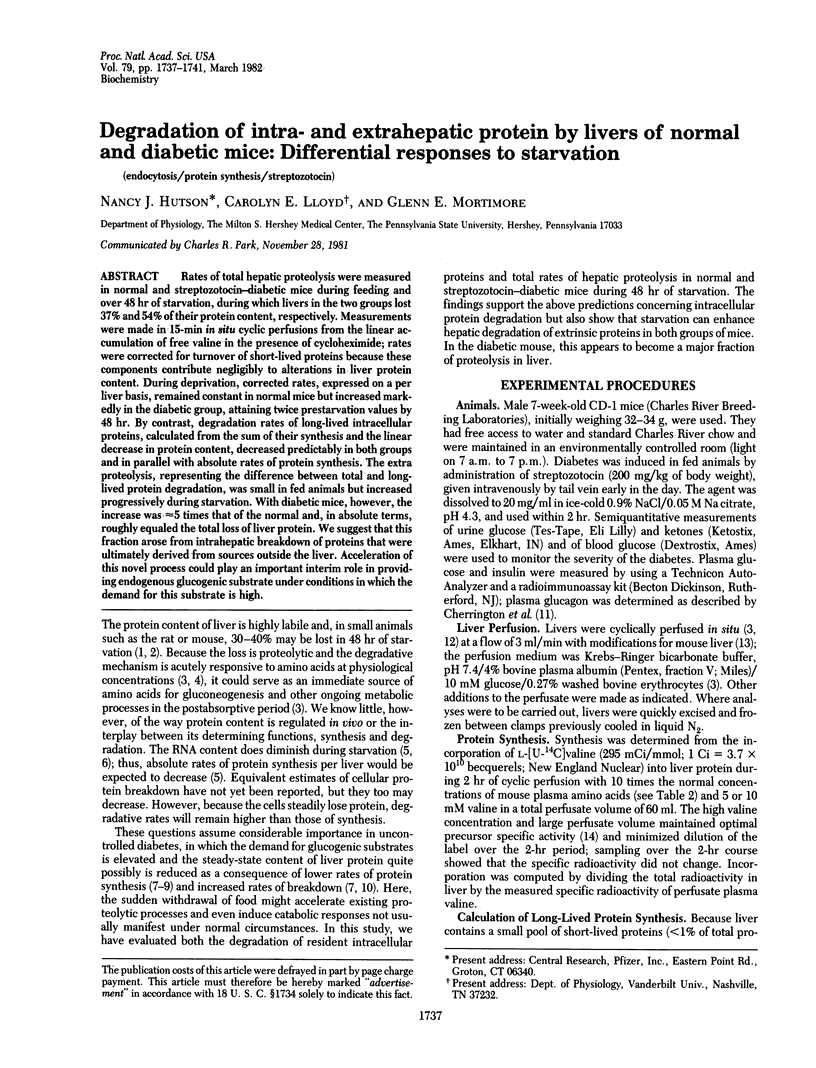
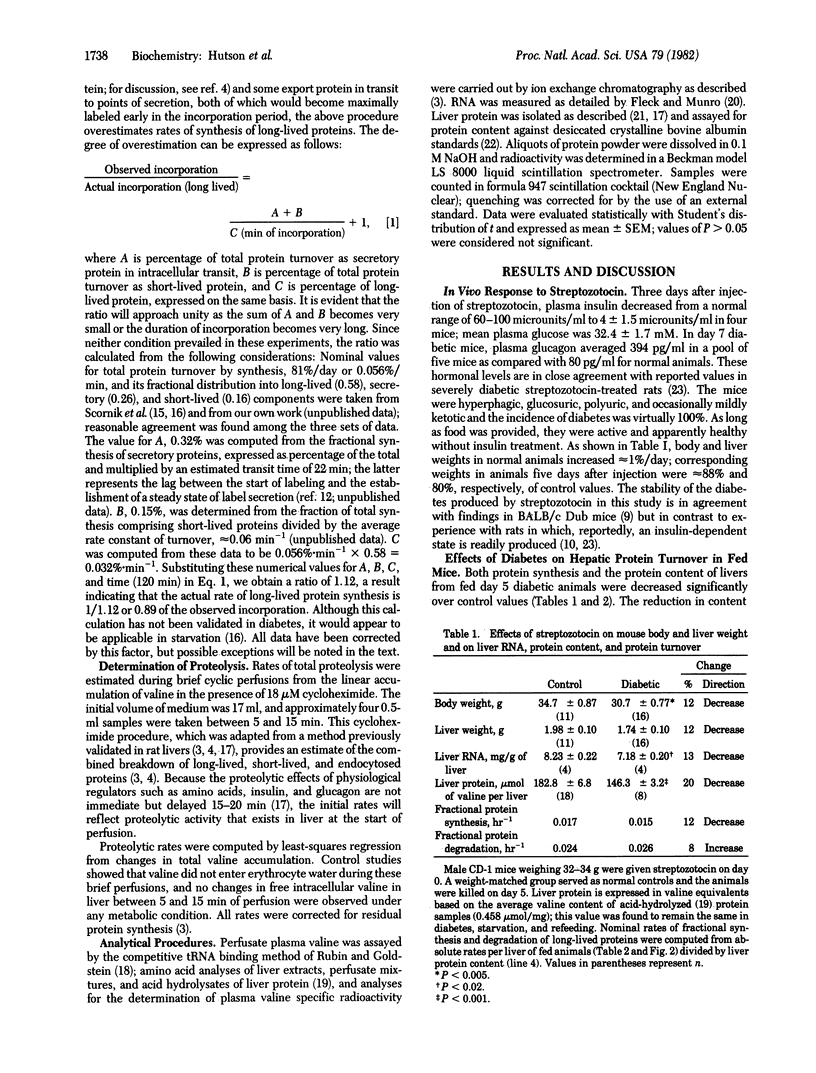
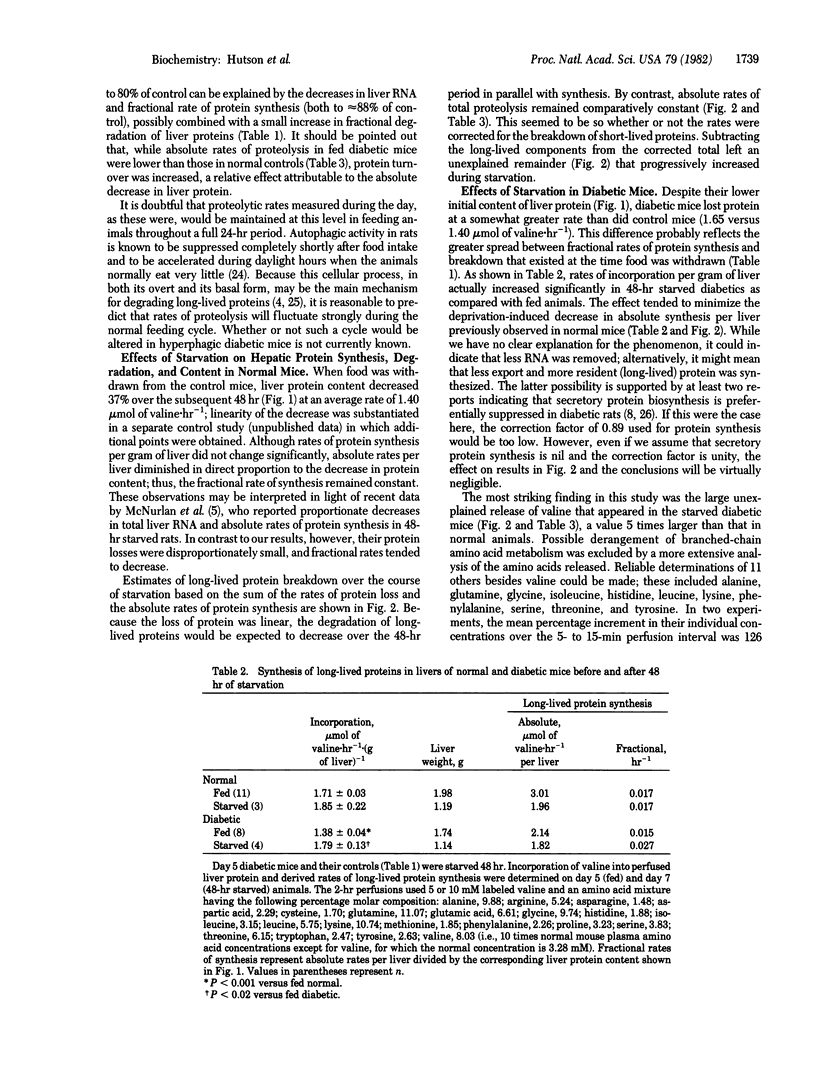
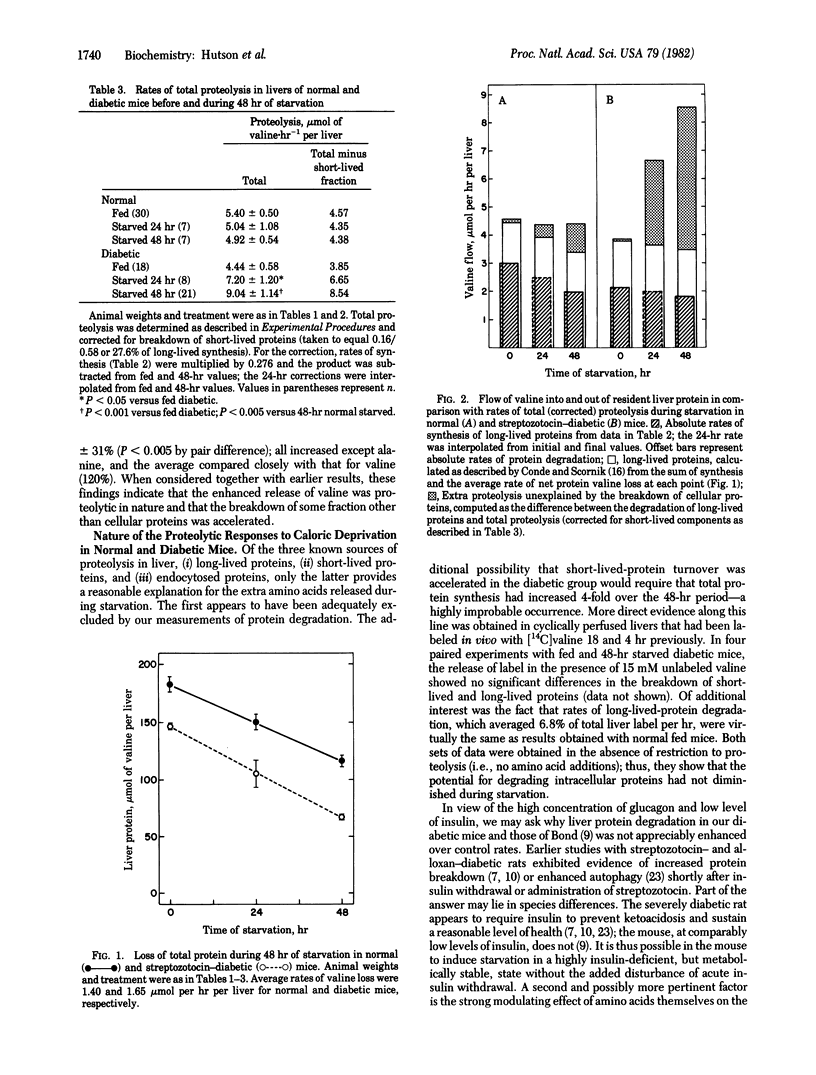
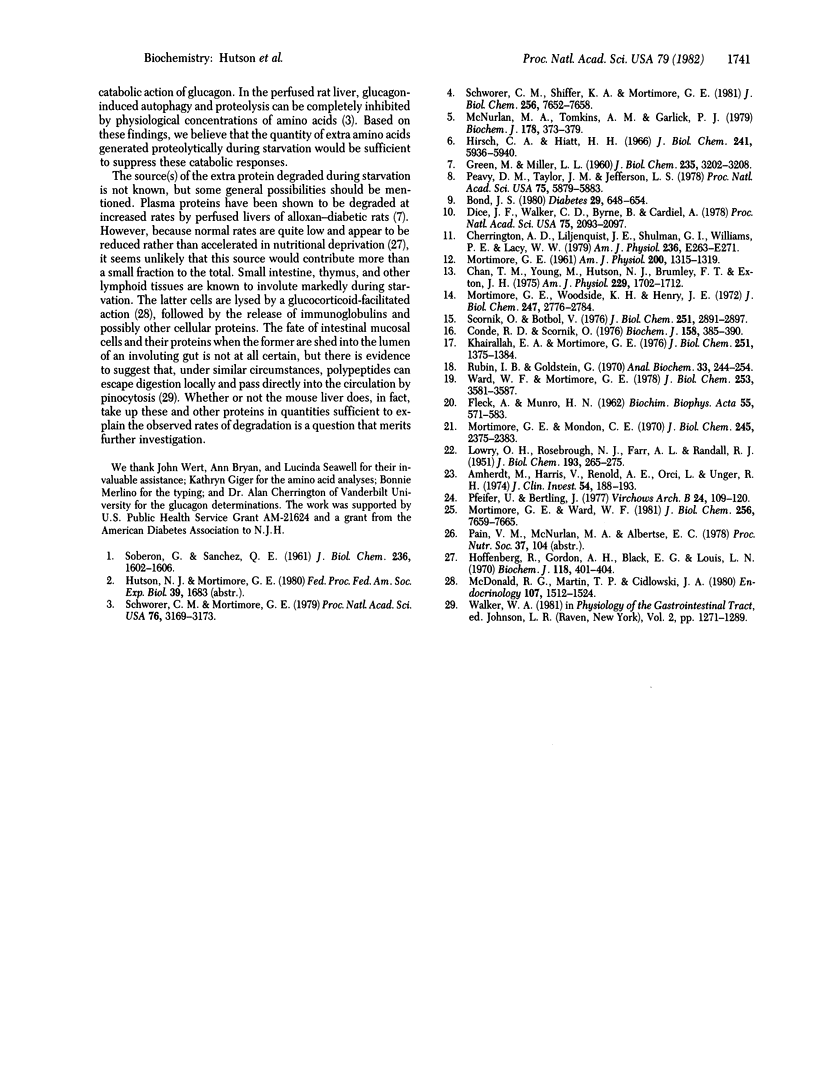
Selected References
These references are in PubMed. This may not be the complete list of references from this article.
- Amherdt M., Harris V., Renold A. E., Orci L., Unger R. H. Hepatic autography in uncontrolled experimental diabetes and its relationships to insulin and glucagon. J Clin Invest. 1974 Jul;54(1):188–193. doi: 10.1172/JCI107742. [DOI] [PMC free article] [PubMed] [Google Scholar]
- Bond J. S. Failure to demonstrate increased protein turnover and intracellular proteinase activity in livers of mice with streptozotocin-induced diabetes. Diabetes. 1980 Aug;29(8):648–654. doi: 10.2337/diab.29.8.648. [DOI] [PubMed] [Google Scholar]
- Chan T. M., Young K. M., Hutson N. J., Brumley F. T., Exton J. H. Hepatic metabolism of genetically diabetic (db/db) mice. I. Carbohydrate metabolism. Am J Physiol. 1975 Dec;229(6):1702–1712. doi: 10.1152/ajplegacy.1975.229.6.1702. [DOI] [PubMed] [Google Scholar]
- Cherrington A. D., Liljenquist J. E., Shulman G. I., Williams P. E., Lacy W. W. Importance of hypoglycemia-induced glucose production during isolated glucagon deficiency. Am J Physiol. 1979 Mar;236(3):E263–E271. doi: 10.1152/ajpendo.1979.236.3.E263. [DOI] [PubMed] [Google Scholar]
- Conde R. D., Scornik O. A. Role of protein degradation in the growth of livers after a nutritional shift. Biochem J. 1976 Aug 15;158(2):385–390. doi: 10.1042/bj1580385. [DOI] [PMC free article] [PubMed] [Google Scholar]
- Dice J. F., Walker C. D., Byrne B., Cardiel A. General characteristics of protein degradation in diabetes and starvation. Proc Natl Acad Sci U S A. 1978 May;75(5):2093–2097. doi: 10.1073/pnas.75.5.2093. [DOI] [PMC free article] [PubMed] [Google Scholar]
- FLECK A., MUNRO H. N. The precision of ultraviolet absorption measurements in the Schmidt-Thannhauser procedure for nucleic acid estimation. Biochim Biophys Acta. 1962 May 14;55:571–583. doi: 10.1016/0006-3002(62)90836-3. [DOI] [PubMed] [Google Scholar]
- GREEN M., MILLER L. L. Protein catabolism and protein synthesis in perfused livers of normal and alloxan-diabetic rats. J Biol Chem. 1960 Nov;235:3202–3208. [PubMed] [Google Scholar]
- Hirsch C. A., Hiatt H. H. Turnover of liver ribosomes in fed and in fasted rats. J Biol Chem. 1966 Dec 25;241(24):5936–5940. [PubMed] [Google Scholar]
- Hoffenberg R., Gordon A. H., Black E. G., Louis L. N. Plasma protein catabolism by the perfused rat liver. The effect of alteration of albumin concentration and dietary protein depletion. Biochem J. 1970 Jul;118(3):401–404. doi: 10.1042/bj1180401. [DOI] [PMC free article] [PubMed] [Google Scholar]
- Khairallah E. A., Mortimore G. E. Assessment of protein turnover in perfused rat liver. Evidence for amino acid compartmentation from differential labeling of free and tRNA-gound valine. J Biol Chem. 1976 Mar 10;251(5):1375–1384. [PubMed] [Google Scholar]
- LOWRY O. H., ROSEBROUGH N. J., FARR A. L., RANDALL R. J. Protein measurement with the Folin phenol reagent. J Biol Chem. 1951 Nov;193(1):265–275. [PubMed] [Google Scholar]
- MORTIMORE G. E. Effect of insulin on potassium transfer in isolated rat liver. Am J Physiol. 1961 Jun;200:1315–1319. doi: 10.1152/ajplegacy.1961.200.6.1315. [DOI] [PubMed] [Google Scholar]
- MacDonald R. G., Martin T. P., Cidlowski J. A. Glucocorticoids stimulate protein degradation in lymphocytes: a possible mechanism of steroid-induced cell death. Endocrinology. 1980 Nov;107(5):1512–1524. doi: 10.1210/endo-107-5-1512. [DOI] [PubMed] [Google Scholar]
- McNurlan M. A., Tomkins A. M., Garlick P. J. The effect of starvation on the rate of protein synthesis in rat liver and small intestine. Biochem J. 1979 Feb 15;178(2):373–379. doi: 10.1042/bj1780373. [DOI] [PMC free article] [PubMed] [Google Scholar]
- Mortimore G. E., Mondon C. E. Inhibition by insulin of valine turnover in liver. Evidence for a general control of proteolysis. J Biol Chem. 1970 May 10;245(9):2375–2383. [PubMed] [Google Scholar]
- Mortimore G. E., Ward W. F. Internalization of cytoplasmic protein by hepatic lysosomes in basal and deprivation-induced proteolytic states. J Biol Chem. 1981 Jul 25;256(14):7659–7665. [PubMed] [Google Scholar]
- Mortimore G. E., Woodside K. H., Henry J. E. Compartmentation of free valine and its relation to protein turnover in perfused rat liver. J Biol Chem. 1972 May 10;247(9):2776–2784. [PubMed] [Google Scholar]
- Peavy D. E., Taylor J. M., Jefferson L. S. Correlation of albumin production rates and albumin mRNA levels in livers of normal, diabetic, and insulin-treated diabetic rats. Proc Natl Acad Sci U S A. 1978 Dec;75(12):5879–5883. doi: 10.1073/pnas.75.12.5879. [DOI] [PMC free article] [PubMed] [Google Scholar]
- Pfeifer U., Bertling J. A morphometric study of the inhibition of autophagic degradation during restorative growth of liver cells in rats re-fed after starvation. Virchows Arch B Cell Pathol. 1977 Jun 24;24(2):109–120. doi: 10.1007/BF02889272. [DOI] [PubMed] [Google Scholar]
- Rubin I. B., Goldstein G. An ultrasensitive isotope dilution method for the determination of L-amino acids. Anal Biochem. 1970 Feb;33(2):244–254. doi: 10.1016/0003-2697(70)90293-9. [DOI] [PubMed] [Google Scholar]
- Schworer C. M., Mortimore G. E. Glucagon-induced autophagy and proteolysis in rat liver: mediation by selective deprivation of intracellular amino acids. Proc Natl Acad Sci U S A. 1979 Jul;76(7):3169–3173. doi: 10.1073/pnas.76.7.3169. [DOI] [PMC free article] [PubMed] [Google Scholar]
- Schworer C. M., Shiffer K. A., Mortimore G. E. Quantitative relationship between autophagy and proteolysis during graded amino acid deprivation in perfused rat liver. J Biol Chem. 1981 Jul 25;256(14):7652–7658. [PubMed] [Google Scholar]
- Scornik O. A., Botbol V. Role of changes in protein degradation in the growth of regenerating livers. J Biol Chem. 1976 May 25;251(10):2891–2897. [PubMed] [Google Scholar]
- Ward W. F., Mortimore G. E. Compartmentation of intracellular amino acids in rat liver. Evidence for an intralysosomal pool derived from protein degradation. J Biol Chem. 1978 May 25;253(10):3581–3587. [PubMed] [Google Scholar]


